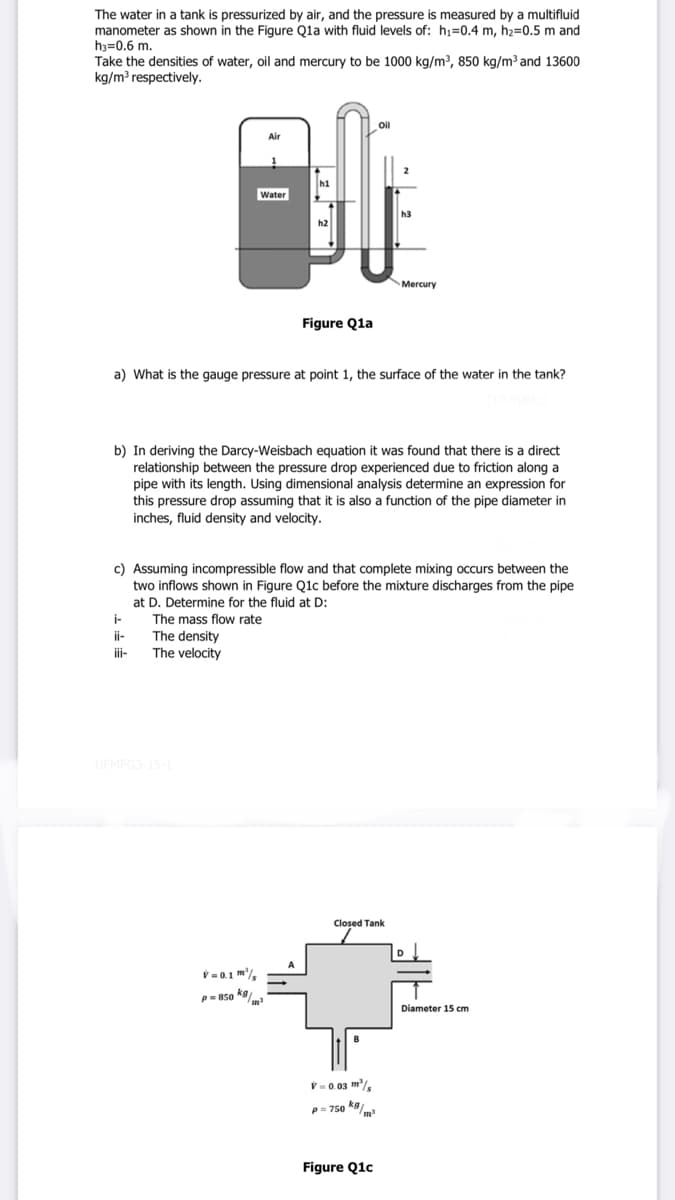The water in a tank is pressurized by air, and the pressure is measured by a multifluid manometer as shown in the Figure Qla with fluid levels of: hi=0.4 m, h2=0.5 m and h3=0.6 m. Take the densities of water, oil and mercury to be 1000 kg/m³, 850 kg/m³ and 13600 kg/m respectively. Oil Water h3 h2 Mercury Figure Qla a) What is the gauge presSure at point 1, the surface of the water in the tank? b) In deriving the Darcy-Weisbach equation it was found that there is a direct relationship between the pressure drop experienced due to friction along a pipe with its length. Using dimensional analysis determine an expression for this pressure drop assuming that it is also inches, fluid density and velocity. function f the pipe diameter in c) Assuming incompressible flow and that complete mixing occurs between the two inflows shown in Figure Q1c before the mixture discharges from the pipe at D. Determine for the fluid at D: i- The mass flow rate The density The velocity ii- i- Closed Tank p-850 k Diameter 15 cm V-0.03 m. p-750 Figure Q1c
The water in a tank is pressurized by air, and the pressure is measured by a multifluid manometer as shown in the Figure Qla with fluid levels of: hi=0.4 m, h2=0.5 m and h3=0.6 m. Take the densities of water, oil and mercury to be 1000 kg/m³, 850 kg/m³ and 13600 kg/m respectively. Oil Water h3 h2 Mercury Figure Qla a) What is the gauge presSure at point 1, the surface of the water in the tank? b) In deriving the Darcy-Weisbach equation it was found that there is a direct relationship between the pressure drop experienced due to friction along a pipe with its length. Using dimensional analysis determine an expression for this pressure drop assuming that it is also inches, fluid density and velocity. function f the pipe diameter in c) Assuming incompressible flow and that complete mixing occurs between the two inflows shown in Figure Q1c before the mixture discharges from the pipe at D. Determine for the fluid at D: i- The mass flow rate The density The velocity ii- i- Closed Tank p-850 k Diameter 15 cm V-0.03 m. p-750 Figure Q1c
Engineering Fundamentals: An Introduction to Engineering (MindTap Course List)
5th Edition
ISBN:9781305084766
Author:Saeed Moaveni
Publisher:Saeed Moaveni
Chapter9: Mass And Mass-related Variables In Engineering
Section: Chapter Questions
Problem 2P
Related questions
Question

Transcribed Image Text:The water in a tank is pressurized by air, and the pressure is measured by a multifluid
manometer as shown in the Figure Qla with fluid levels of: h1=0.4 m, h2=0.5 m and
h3=0.6 m.
Take the densities of water, oil and mercury to be 1000 kg/m³, 850 kg/m³ and 13600
kg/m³ respectively.
oil
h1
Water
h3
h2
Mercury
Figure Q1a
a) What is the gauge pressure at point 1, the surface of the water in the tank?
b) In deriving the Darcy-Weisbach equation it was found that there is a direct
relationship between the pressure drop experienced due to friction along a
pipe with its length. Using dimensional analysis determine an expression for
this pressure drop assuming that it is also a function of the pipe diameter in
inches, fluid density and velocity.
c) Assuming incompressible flow and that complete mixing occurs between the
two inflows shown in Figure Q1c before the mixture discharges from the pipe
at D. Determine for the fluid at D:
i-
The mass flow rate
The density
The velocity
i-
i-
UFMFGS-15-
Closed Tank
A
v = 0.1 m'/
p = 850 k9/m
Diameter 15 cm
V-0.03 m
p = 750 ka
m
Figure Q1c
Expert Solution
This question has been solved!
Explore an expertly crafted, step-by-step solution for a thorough understanding of key concepts.
This is a popular solution!
Trending now
This is a popular solution!
Step by step
Solved in 2 steps with 6 images

Knowledge Booster
Learn more about
Need a deep-dive on the concept behind this application? Look no further. Learn more about this topic, civil-engineering and related others by exploring similar questions and additional content below.Recommended textbooks for you

Engineering Fundamentals: An Introduction to Engi…
Civil Engineering
ISBN:
9781305084766
Author:
Saeed Moaveni
Publisher:
Cengage Learning

Engineering Fundamentals: An Introduction to Engi…
Civil Engineering
ISBN:
9781305084766
Author:
Saeed Moaveni
Publisher:
Cengage Learning